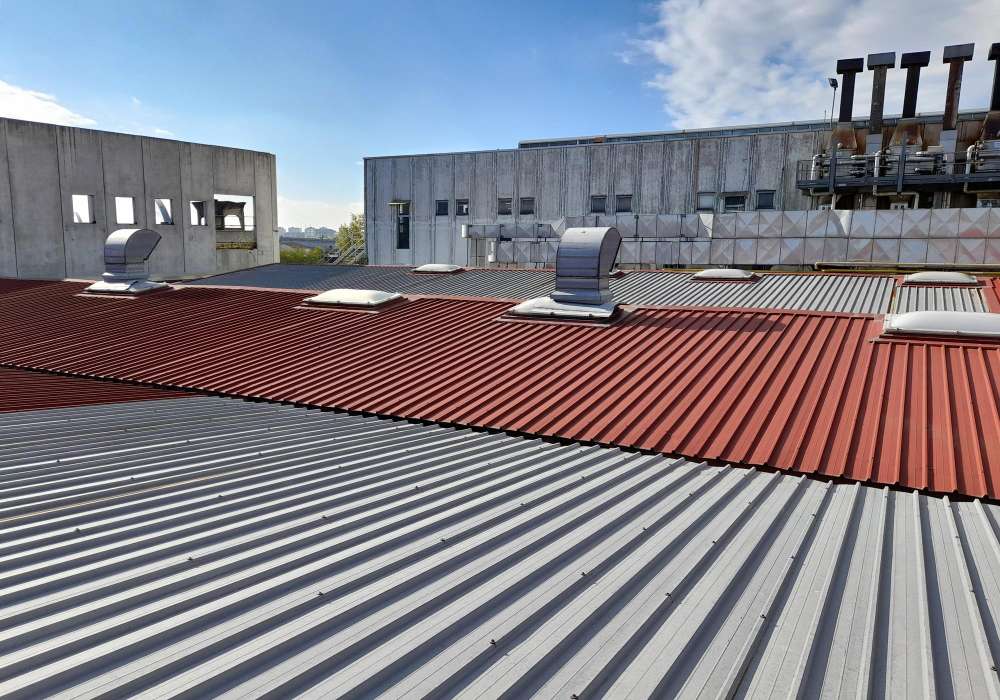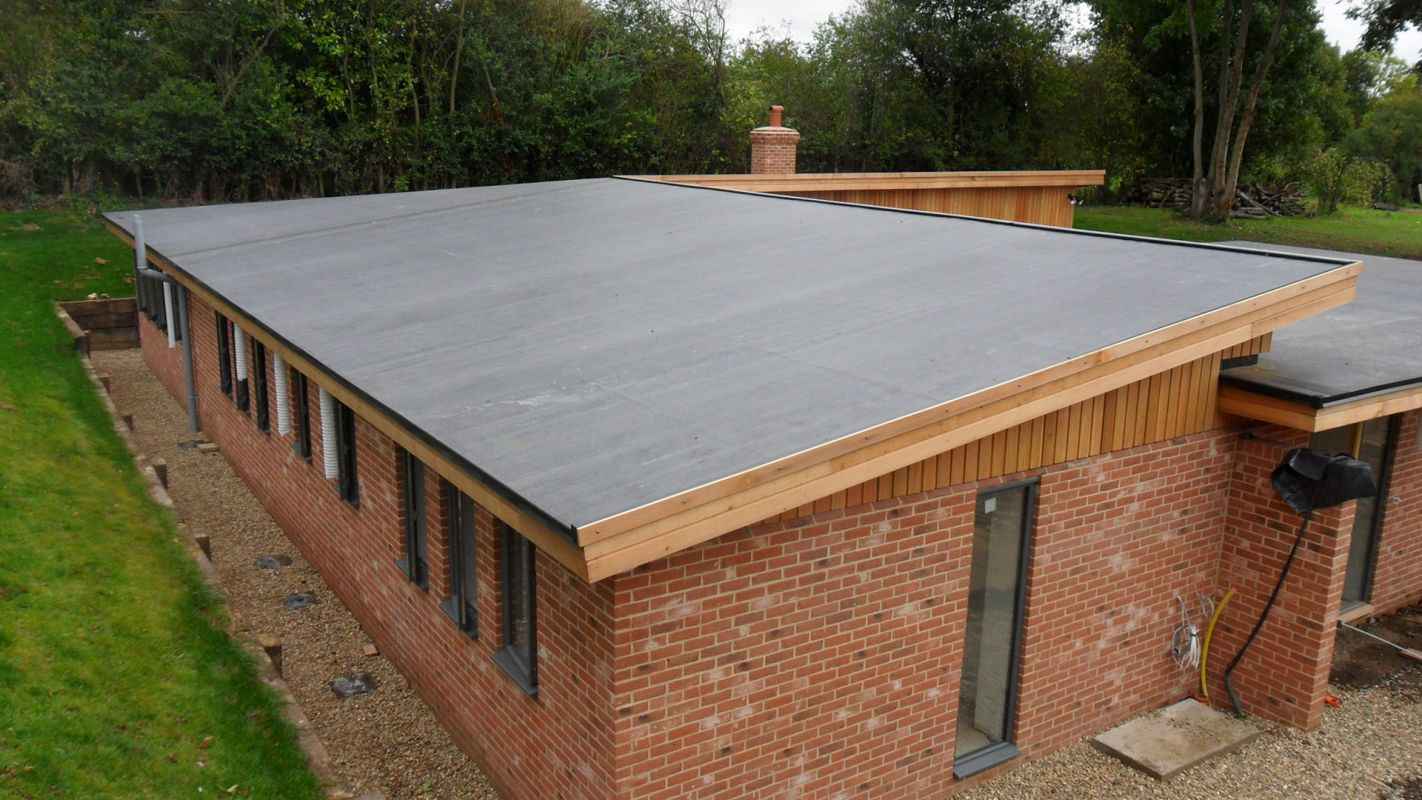What is a Flat Roof?
Table of Contents

A flat roof is a roof with a slight slope—typically 1–10 degrees—that allows for water drainage while appearing level. Commonly used on garages, extensions, and commercial buildings, flat roofs are usually covered in waterproof membranes like EPDM or GRP. They offer a modern look, ease of access, and practical use of space.
Flat roofs have evolved significantly thanks to modern materials and innovative technologies. Whether you’re planning a residential build or a commercial project, flat roofs have become a popular option in the UK — and with good reason. But what makes them so effective? What exactly is a flat roof? In this blog, we unpack everything you need to know about flat roofs.
What is a Flat Roof?
Despite the name, flat roofs aren’t completely flat. Instead, they have a slight pitch — typically between 1–10 degrees — to allow water drainage. This design is covered with a waterproof membrane and commonly found on extensions, garages, carports, and outbuildings. You’ll often find them used in both residential and commercial applications due to their versatility.
Types of Flat Roofs
Different flat roofing materials offer varying lifespans, durability, and installation complexity. Below are the most common types used in the UK:
Built-Up Roofing (BUR)
Also known as tar and gravel roofs, BUR systems have been in use for over a century. These roofs consist of multiple layers of tar and gravel and typically last between 10–15 years. They offer good waterproofing, fire resistance, and insulation, though the gravel layer often needs periodic replacement.
Concrete Roofs
Concrete roofs are layered systems built with cement, sand, and water, often topped with vapour barriers and insulation. These are weather-resistant, fireproof, low maintenance, and can last up to 50 years.
EPDM (Ethylene Propylene Diene Monomer)
This synthetic rubber membrane is a budget-friendly option and widely used in commercial flat roofing. It’s lightweight, recyclable, fireproof, and water-resistant with a potential lifespan of 10–50 years. Learn more about EPDM and compare with other materials in our guide to the best flat roofing materials.
GRP (Glass Reinforced Polyester)
Made of fibreglass and polyester, GRP is a single-ply laminate that’s easy to install and maintain. Best used in low foot traffic areas, it lasts between 25–50 years and is both economical and durable.
Metal Roofs
Flat metal roofs are constructed using fastened sheets of steel, zinc, aluminium, or copper. These materials offer a lifespan of up to 100 years and are recyclable, customisable, and weather-resistant. Read more about different types of metal roofing.
Modified Bitumen Systems (MBS)
This single-ply material combines fibreglass and tar and is well-suited for sheds and small buildings. It can be coated with elastomeric paint for UV protection and generally lasts 15–30 years.
PVC (Polyvinyl Chloride)
PVC is a flexible, thermoplastic waterproof membrane. Heat-welded at the seams, it’s resistant to chemicals, fire, wind, and UV rays, with a lifespan of around 20–30 years.
Advantages of Flat Roofs
Cost-Effective Construction
Flat roofs are more economical than pitched roofs — not just in installation but also in repairs and extensions. Compare with flat and pitched roof extensions.
Additional Storage Space
Whether you want to add solar panels, store ladders, or install a satellite dish, a flat roof gives you that added outdoor space without ruining your property’s aesthetic.
Ease of Access
Routine maintenance like clearing debris or inspecting gutters is simpler on flat surfaces. This accessibility makes them especially practical for DIY enthusiasts. Check our roof maintenance checklist.
Long Lifespan
Modern materials like EPDM or GRP offer lifespans of up to 50 years and beyond. They’re also more durable and water-resistant than older materials like traditional felt.
Multi-Use Space
From a roof garden to a private lounge space, the usability of a flat roof is a major perk for urban homes.


Disadvantages of Flat Roofs
Poor Drainage
Flat roofs drain water less efficiently than pitched roofs. Poor drainage can cause ponding, leaks, or premature material failure. Use high-quality felts and ensure proper maintenance to mitigate these issues.
Shorter Lifespan (Traditional Materials)
Old-school felt roofs only last 10–15 years. Upgrading to EPDM, GRP, or polyurethane systems can greatly improve durability and performance.
Temperature Sensitivity
Flat roofs can get extremely hot in summer and cold in winter. However, this is less of a concern when used on garages or sheds.
Costly Repairs
Flat roof repairs can be pricier due to their structure. Regular inspections — especially in autumn and spring — can prevent major issues and save money.
Ideal Applications of Flat Roofs
Dry, Sunny Climates
In regions with minimal rainfall, flat roofs perform exceptionally well since their limited drainage isn’t a major issue.
Modern Architecture
Flat roofs perfectly match minimalist and modern designs, offering a clean aesthetic and contemporary appeal. Browse 30 roof types in the UK.
Small Lots
Homeowners with limited space can benefit from the rooftop as an extra storage or recreational area.
Solar-Ready Homes
Unlike pitched roofs, flat roofs allow solar panels to be installed in the most optimal direction for sunlight absorption. Learn more about solar panels on flat roofs.
Maintenance Tips for Flat Roofs
- Inspect twice a year (ideally autumn and spring)
- Check roofing membranes for wear
- Trim overhanging tree branches
- Inspect flashing and sealants
- Keep drains and gutters clear
Frequent inspections help prevent issues like blistering, ridging, ponding, or leaks.
FAQs About Flat Roofs
Are flat roofs completely flat?
No, flat roofs have a slight pitch between 1–10 degrees to allow rainwater to drain off effectively.
How long does a flat roof last in the UK?
Depending on the material, a flat roof in the UK can last anywhere from 10 to 50 years or more. Modern options like GRP and EPDM tend to last the longest.
What is the best material for a flat roof?
The best material depends on your needs. EPDM is budget-friendly and durable, GRP offers low maintenance, and metal roofs provide the longest lifespan.
Do flat roofs need planning permission in the UK?
Generally, no planning permission is needed if the flat roof is part of a permitted development. However, exceptions apply for listed buildings or certain conservation areas.
Expert Installation by Positive Roofing
Ready to experience the benefits of a flat roof? Trust Positive Roofing for professional installation and expert advice. We offer tailored roofing solutions using the best materials and practices. Call 07305 680701 or email positiveroofing@hotmail.com to get started today.
